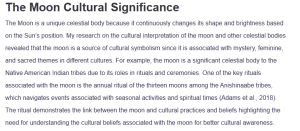The Moon Cultural Significance
The Moon is a unique celestial body because it continuously changes its shape and brightness based on the Sun’s position. My research on the cultural interpretation of the moon and other celestial bodies revealed that the moon is a source of cultural symbolism since it is associated with mystery, feminine, and sacred themes in different cultures. For example, the moon is a significant celestial body to the Native American Indian tribes due to its roles in rituals and ceremonies. One of the key rituals associated with the moon is the annual ritual of the thirteen moons among the Anishinaabe tribes, which navigates events associated with seasonal activities and spiritual times (Adams et al., 2018). The ritual demonstrates the link between the moon and cultural practices and beliefs highlighting the need for understanding the cultural beliefs associated with the moon for better cultural awareness.
The inquiry process was essential in understanding the research process. One of the things I learned from the process is that good research requires identifying credible sources and critically reviewing different viewpoints. I also learned that the research process can be broken down into selecting a topic related to a specific area of interest and developing a research question to function as a guide in looking for information on the topic of interest. I might use what I have learned about inquiry to develop an inquiry assignment in a classroom with my students by providing students with guiding questions to help them establish the focus of their research and suggest databases that they can use to access credible sources. I would also include families in the process by encouraging the students to interview family members about their own cultural beliefs regarding the moon or to share stories passed down through generations. I can also encourage students to participate in community activities such as stargazing nights that could tie home and school experiences in a shared learning community.
References
Adams, J., Clarke, L., Kwan-Lafond, D., Mather, M., Thornhill, N., Winterstein, S., Meness, J., Kinsella, S., Mutamba, M., Roffey, C., McQuabbie, J., Enberg, S., & Aura, L. (2018). Our Stories: First Peoples in Canada. Centennial College.
ORDER A PLAGIARISM-FREE PAPER HERE
We’ll write everything from scratch
Question 
PROFFESOR INSTRUCTIONS: There is no need to observe the moon this week, unless you would like to continue your connection with the universe!! This week you will research your final research question. Please remember to use reputable sources online. If you are unsure about reliable sources, please take a browse of this article https://www.coloradotech.edu/blog/2024/april/how-to-find-reputable-sources-online
The NASA website is one wonderful resource for this and other space related learning – for yourself and for your students.
Then, in no more than two paragraphs, please summarize what you learned about the moon, based on your research question. In an additional paragraph, note what you learned about the inquiry process. Include how you might use what you have learned about inquiry to develop an inquiry assignment in a classroom with your students (this does not need to be a moon journal) – but perhaps an inquiry study on a topic of interest your students or a requied topic of study. How could you include families in the process?

The Moon Cultural Significance
I UPLOADED MY MOON JOURNAL FROM WEEK 5 SO THAT YOU CAN SEE THE RESEARCH QUESTION YOU CAME UP WITH. YOU ARE GOING TO RESEARCH THE QUESTION YOU CAN UP WITH AND THEN IN NO MORE THAN TWO PARAGRAPHS YOUR ARE GOING TO SUMMARIZE WHAT YOU LEARNED ABOUT THE MOON, BASED ON MY REASEARCH QUESTION. IN AN ADDITIONAL PARAGRAPH, NOTE WHAT YOU LEARNED ABOUT THE INQUIRY PROCESS. Include how you might use what you have learned about inquiry to develop an inquiry assignment in a classroom with your students (this does not need to be a moon journal) – but perhaps an inquiry study on a topic of interest your students or a requied topic of study. How could you include families in the process?
